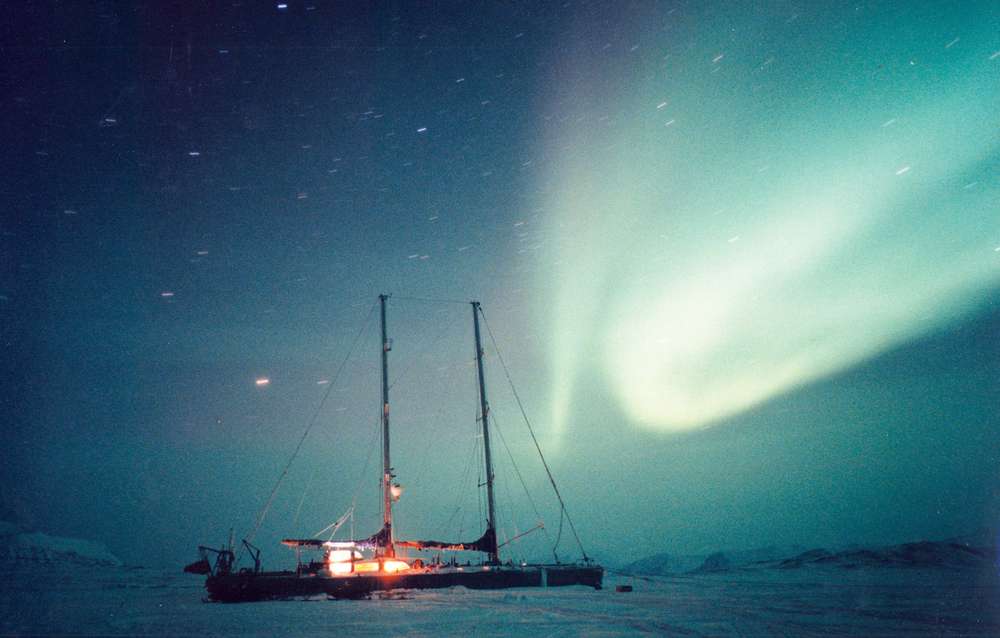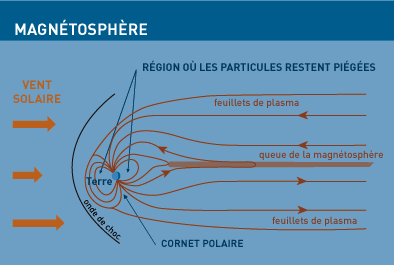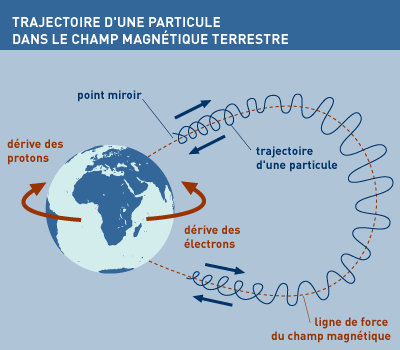Polar Encyclopædia
EARTH'S ATMOSPHERE

A polar aurora above the “Antarctica” as it winters in Spitsbergen. © F. Latreille/Septième continent.
AN ENVELOPE OF GAS RIGHT AROUND THE WORLD
The air that we breathe is contained in a layer of gases that envelopes the whole of our planet. Nearly half of this fluid mass is to be found below an altitude of 5,000 metres, which is not very far when you consider that the radius of the Earth is 6,400 kilometres! Yet it is the Earth’s atmosphere that creates the conditions that enable life to thrive on our planet.

FOUR SUCCESSIVE LAYERS
FOUR SUCCESSIVE LAYERS
The lowest layer of the atmosphere (the troposphere), in which we live, is the most dense. It is where the clouds are and it controls the climate. Its upper limit is at an average altitude of 12 km (-60°C). Above the troposphere, there are three further levels — the stratosphere, the mesosphere and the thermosphere – with progressively lower temperatures, and above 1,500 km there is nothing but the vacuum of outer space.
WHAT IS THE ATMOSPHERE MADE OF ?
The atmosphere is made up of nitrogen, oxygen, argon and a number of rare gases in very stable proportions. Only the proportions of gases produced by human activities (carbon dioxide, ozone, etc.), which are present in quite small amounts, are variable. These gases, that we call “air”, account for 98% of the weight of the atmosphere; the rest is made up fine airborne particles (dust, pollen, salt crystals, etc.).
Very unstable weather patterns : Successive anticyclones and depressions mean that the Earth’s atmosphere is anything but calm. What causes these high- and low pressure systems? The Sun and the Earth’s rotation. The Sun heats the surface of the Earth unevenly, generating a series of high- and low-pressure zones; the Earth’s rotation means that the winds spiral around these zones in different directions.
WAY UP ABOVE THE CLOUDS
As we rise up into the atmosphere, the temperature first of all decreases until it is about -50°C above the poles and -85°C above the Equator (where the air temperature at altitude is colder than at the poles…). Because of the Earth’s rotation this ceiling, called the tropopause, is three times lower (6 km) at the poles than it is at the Equator (17 km). It forms the limit of the lower atmosphere, the troposphere, where we live. This troposphere contains almost all (99.99%) of the water vapour in the air and it produces all the rain and controls our climate. The troposphere is also where aircraft fly. Above the troposphere is the stratosphere, where the air temperature rises again until it reaches 0°C at an altitude of about 45 km and then falls to -90°C at a distance of 90 km from Earth. This forms another layer called the mesosphere. Then the temperature rises once more to reach more than 1,000°C in the thermosphere.
STRANGE INTER-PLANETARY TRAVELLERS
The zones beyond the Earth’s atmosphere, known as outer space, are not in fact empty. Space is criss-crossed by all sorts of particles that are expelled by the stars and above all the Sun. Most of these particles are identical to those contained in the atoms that make up matter as we know it (electrons, neutrons and protons). The others, more unusual, are called a-particles, mesons, neutrinos, etc. So the Earth’s environment is constantly bombarded by these different particles.
Space is also criss-crossed by visible light and by all sorts of rays belonging to the same family (electromagnetic waves) but which are invisible to the human eye: g-rays, x-rays, ultraviolet, infrared, microwaves, radio waves, etc.
The energy contained in these particles and waves depends on how they were generated.

LIKE A SCARF BLOWING IN THE WIND: THE MAGNETOSPHERE
In the context of the space that surrounds it, the Earth behaves like a giant magnet, and its magnetic field acts like a huge invisible protective cocoon around our planet. This zone affected by this field, called the magnetosphere, is not at all round, but stretches out into space lopsided, like the tail of a comet.
This is because the Sun constantly “blows” a wind of particles (the solar wind) that strikes the magnetosphere, squashing it against the front (or daylight zone) of the Earth and stretching it out the other (or night-time) side for millions of kilometres, well beyond the orbit of the Moon, rather like a scarf blowing in the wind.
THE COSMIC INFLUENCE ON MAN
By channelling the interplanetary particles around the outside of the Earth, the magnetosphere protects us from them, but it also generates other surprising phenomena. For example, the solar wind often disrupts radio communications (via magnetic storms). The particles were also the cause of the huge power black-out in New York one night in 1972, by generating strong circumterrestrial currents. And they were responsible for the premature re-entry of the Skylab spacecraft in 1979, when it was slowed by a gust of solar wind. Last but not least, these solar particles can also have a negative effect on health if human beings are exposed to them.
COSMIC PARTICLES CHANNELLED BY THE MAGNET EARTH
At the Earth’s two poles, where the lines of its magnetic field emerge and re-enter the enormous “magnet”, there are huge magnetic cones or funnels with their mouth opening onto space. When “charged” cosmic particles enter the magnetosphere, they follow the lines of force of the Earth’s magnetic field as if on giant rails. In most cases they are unable to get very far into the cones where the rails come closer together, so they “bounce” forever from one pole to the other in a never-ending drift around the globe.
THE POLAR AURORA: A LITTLE OF THE COSMOS MANAGES TO GET IN THROUGH THE EARTH’S WINDOWS…
The particles with the most energy that descend too far into the magnetic cones excite the atoms and molecules that make up our air, causing them to emit light. So the people living in the Deep North are occasionally treated to the magnificent spectacle of an “aurora borealis” lighting up the night sky, an aurora that has nothing to do with the dawn… The colours and shapes generated depend on which atoms are being excited and at what altitude: oxygen produces greenish yellow light, nitrogen produces violet and pink, and hydrogen gives red light. These coloured draperies of light hovering in the night sky are nothing more than a real-time sign of the convulsions and caprices of the Sun.
PHYSICIST’S CORNER
The energy contained in any particle of matter depends on its mass and its speed (kinetic energy). Physicists measure particle energy in electronvolts (EV).
The electronvolt is the energy acquired when an electron is accelerated by a difference in potential of 1 volt. This is a very small charge but very significant at particle scale. Some idea of particle size can be gauged from the fact that 1 volt is 220 times less than the current delivered by a wall socket, and a flow of 600 billion billion electrons per second is needed to set up a current of 1 amp (not quite as much as the power used by the lamp in your living room!). (1 EV = 1.6 10-19J).
DID YOU KNOW ?
The Earth’s overall atmosphere weighs nearly 5 million billion metric tons, yet even this is 3,000 times less than the mass of all the water on Earth.
Polar aurorae can occur (but this is extremely rare…) in non-polar latitudes. History has it that in the year 37 an intense reddish light in the night sky made people in Rome think that Ostia was burning.
Cosmic dust (micro-meteorites), quite different from cosmic particles, also travels across our solar system. Scientists are looking for interplanetary dust that may have fallen to earth, particularly in places like Greenland and the Antarctic. They estimate that between 50 and 100 tons of micro-meteorites (most of which are only 50 to 500 micrometres in size) settle on the Earth’s surface each day. That’s nearly 2,000 times more than the weight of the “real” meteorites that reach the Earth (about 0.03 ton per day).
TO FIND OUT MORE …
BIBLIOGRAPHY
- Dossier pédagogique : L’Arctique et l’environnement boréal (P. Avérous CNDP, 1995)
- Expédition Erebus (J.-L. Etienne/P. Avérous- Arthaud-1994)
- Dossier pédagogique : “EREBUS” : L’environnement polaire 2 (P. Avérous-Autrement dit, CNDP-1994)
- Pleuvra, Pleuvra pas La météo au gré du temps ( R. Chaboud Découvertes Gallimard-1994)
- Encyclopedia Universalis
- La Terre… notre planète (P. Avérous-Nathan-1990)
- Atmosphère, Atmosphère (Science & Vie, Hors série n° 174-1991)
- Quel climat pour demain ? (S. Huet, Calmann-Levy, 2000)
- L’incertitude des climats (R. Kandel, Hachette, 1998)
- Le climat de la Terre (R. Sadourny, DOMINOS, Flammarion, 1994)
Support the project with a donation
The Polar POD expedition is one of the stamp of the pioners, a human adventure coupled with a technological challenge, an oceanographic exploration never before carried out which will mark a milestone in the discovery of the oceans.
Thank you for your support !